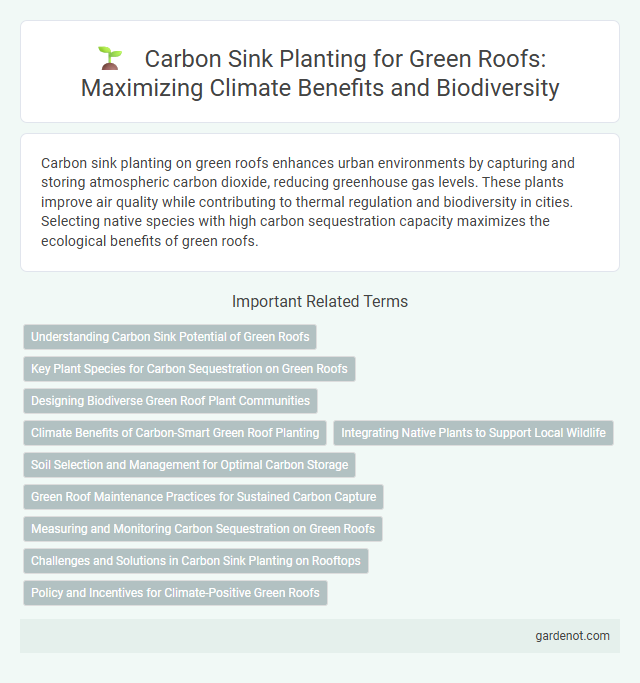Carbon sink planting on green roofs enhances urban environments by capturing and storing atmospheric carbon dioxide, reducing greenhouse gas levels. These plants improve air quality while contributing to thermal regulation and biodiversity in cities. Selecting native species with high carbon sequestration capacity maximizes the ecological benefits of green roofs.
Understanding Carbon Sink Potential of Green Roofs
Green roofs serve as effective carbon sinks by capturing atmospheric CO2 through diverse vegetation layers, significantly reducing urban carbon footprints. Studies show that extensive green roofs can sequester between 50 to 100 grams of carbon per square meter annually, depending on plant species and substrate depth. Optimizing plant selection and soil composition enhances carbon storage capacity, making green roofs a viable strategy for urban climate mitigation.
Key Plant Species for Carbon Sequestration on Green Roofs
Key plant species for carbon sequestration on green roofs include sedums, native grasses, and deep-rooted perennials such as switchgrass (Panicum virgatum) and prairie dropseed (Sporobolus heterolepis), which exhibit high biomass accumulation and efficient carbon fixation. Succulents like Sedum album and Sedum spurium are favored for their drought tolerance and ability to store carbon in thick, fleshy tissues, making them ideal for extensive green roofs. Incorporating these species enhances soil organic carbon content and supports long-term carbon storage, optimizing the green roof's role as an effective urban carbon sink.
Designing Biodiverse Green Roof Plant Communities
Designing biodiverse green roof plant communities enhances carbon sequestration by incorporating a variety of native plant species that optimize photosynthesis and soil carbon storage. Selecting drought-tolerant sedums, grasses, and wildflowers creates resilient ecosystems that improve air quality and support local biodiversity. Integrating deep-rooted perennials further stabilizes soil carbon pools and promotes long-term carbon sink functionality on urban rooftops.
Climate Benefits of Carbon-Smart Green Roof Planting
Carbon-smart green roof planting enhances urban carbon sinks by using vegetation that maximizes carbon sequestration through deep root systems and high photosynthetic capacity. Selecting native, drought-resistant species reduces maintenance emissions and improves soil carbon storage, contributing significantly to climate change mitigation. These strategic plant choices decrease atmospheric CO2 levels, supporting cooler microclimates and reducing the urban heat island effect.
Integrating Native Plants to Support Local Wildlife
Integrating native plants in green roof carbon sink planting enhances local biodiversity by providing essential habitats and food sources for native wildlife, including pollinators and birds. Native species are adapted to the regional climate and soil conditions, ensuring better survival rates and reduced maintenance compared to non-native plants. This approach not only maximizes carbon sequestration but also strengthens urban ecosystems and supports ecological resilience.
Soil Selection and Management for Optimal Carbon Storage
Selecting nutrient-rich, well-draining soil with high organic matter content enhances microbial activity and carbon sequestration in green roof systems. Incorporating biochar and compost improves soil structure and increases carbon retention capacity, while regular monitoring of pH and moisture levels optimizes conditions for root growth and carbon stabilization. Effective soil management practices, including minimal disturbance and appropriate irrigation, support long-term carbon sink functionality in green roof environments.
Green Roof Maintenance Practices for Sustained Carbon Capture
Regular green roof maintenance, including proper irrigation, pruning, and soil health monitoring, enhances the carbon sequestration capacity of carbon sink plantings by promoting robust vegetation growth. Selecting diverse, native plant species optimized for carbon capture ensures sustained photosynthetic activity and long-term carbon storage. Routine removal of invasive species and periodic nutrient supplementation further supports the ecological balance necessary for maximal carbon fixation on green roofs.
Measuring and Monitoring Carbon Sequestration on Green Roofs
Measuring and monitoring carbon sequestration on green roofs involve quantifying the amount of carbon dioxide captured and stored by specific plant species and substrate compositions. Techniques such as remote sensing, gas flux analysis, and biomass sampling provide accurate data on carbon uptake and retention over time. Continuous monitoring supports optimizing green roof designs to maximize carbon sink potential and contribute to urban climate mitigation strategies.
Challenges and Solutions in Carbon Sink Planting on Rooftops
Carbon sink planting on rooftops faces challenges such as limited soil depth, water retention difficulties, and the need for plant species that efficiently sequester carbon in urban environments. Solutions include utilizing lightweight engineered growing media, installing advanced irrigation systems to maintain optimal moisture levels, and selecting drought-resistant, high biomass plants like sedums and native grasses specifically adapted to rooftop microclimates. Incorporating biochar into soil substrates enhances carbon sequestration capacity while improving nutrient retention and microbial activity, making rooftop carbon sinks more effective and sustainable.
Policy and Incentives for Climate-Positive Green Roofs
Climate policies increasingly prioritize carbon sink planting on green roofs to enhance urban carbon sequestration and reduce greenhouse gas emissions. Governments implement incentives such as tax credits, grants, and subsidies to encourage the adoption of climate-positive green roofing technologies. These initiatives support sustainable urban development and contribute to achieving national carbon reduction targets.
Carbon sink planting Infographic

 gardenot.com
gardenot.com